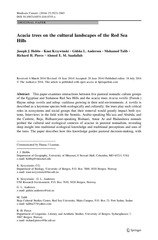| dc.contributor.author | Hobbs, Joseph J. | eng |
| dc.contributor.author | Krzywinski, Knut | eng |
| dc.contributor.author | Andersen, Gidske Leknæs | eng |
| dc.contributor.author | Talib, Mohamed | eng |
| dc.contributor.author | Pierce, Richard H. | eng |
| dc.contributor.author | Saadallah, Ahmed Ebaid Mohamed | eng |
| dc.date.accessioned | 2014-12-22T09:04:44Z | |
| dc.date.available | 2014-12-22T09:04:44Z | |
| dc.date.issued | 2014-07-18 | eng |
| dc.identifier.issn | 0960-3115 | en_US |
| dc.identifier.uri | http://hdl.handle.net/1956/9008 | |
| dc.description.abstract | This paper examines interactions between five pastoral nomadic culture groups of the Egyptian and Sudanese Red Sea Hills and the acacia trees Acacia tortilis (Forssk.) Hayne subsp. tortilis and subsp. raddiana growing in their arid environments. A. tortilis is described as a keystone species both ecologically and culturally: the trees play such critical roles in ecosystems and social groups that their removal would greatly impact both systems. Interviews in the field with the Semitic, Arabic-speaking Ma‘aza and Ababda, and the Cushitic, Beja, Bidhaawyeet-speaking Bishaari, Amar Ar and Hadandawa nomads probed the cultural and ecological contexts of acacias in pastoral nomadism, revealing deep insight into traditional ecological knowledge and traditional perceptions and uses of the trees. The paper describes how this knowledge guides pastoral decision-making, with acacias as a particularly critical component of the pastoral livelihood in both normal and stressful circumstances. A. tortilis is the most important reliable vegetation resource for nomads while also providing fuel and other useful products, ecosystem services for people and animals, and increased biodiversity by providing diverse microhabitats and resources for other species. We describe aspects of kinship, territorial organization, spiritual beliefs and tribal law underlying the significance of trees on the cultural landscape. We discuss environmental and economic challenges to human/tree relationships and to pastoral livelihoods. We challenge views of nomads as agents of ecological destruction, and propose maintenance and restoration of traditional pastoralism as viable alternatives in dryland development. | en_US |
| dc.language.iso | eng | eng |
| dc.publisher | Springer | en_US |
| dc.rights | Attribution CC BY | eng |
| dc.rights.uri | http://creativecommons.org/licenses/by/4.0 | eng |
| dc.subject | Acacia tortilis | eng |
| dc.subject | Eastern Sahara | eng |
| dc.subject | Pastoral nomadism | eng |
| dc.subject | Cultural landscape | eng |
| dc.subject | Cultural keystone species | eng |
| dc.title | Acacia trees on the cultural landscapes of the Red Sea Hills | en_US |
| dc.type | Peer reviewed | |
| dc.type | Journal article | |
| dc.description.version | publishedVersion | en_US |
| dc.rights.holder | Copyright 2014 The Authors | en_US |
| dc.identifier.doi | https://doi.org/10.1007/s10531-014-0755-x | |
| dc.identifier.cristin | 1141554 | |
| dc.source.journal | Biodiversity and Conservation | |
| dc.source.40 | 23 | |
| dc.source.14 | 12 | |
| dc.source.pagenumber | 2923-2943 | |

